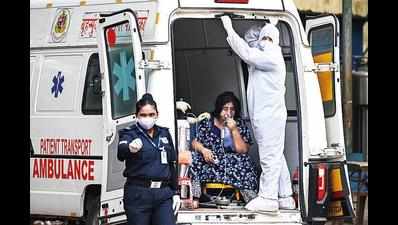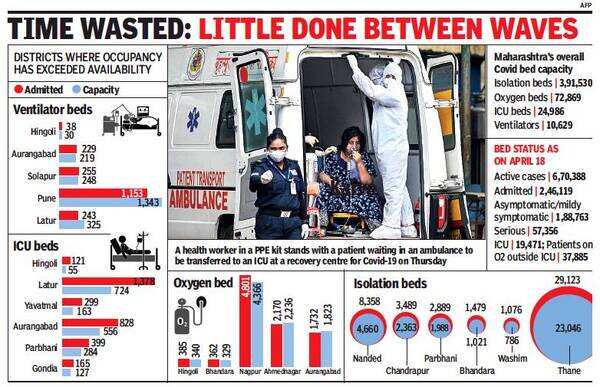- News
- City News
- mumbai News
- Maharashtra caught napping: Virus spreads faster than medical infra in interiors
Trending
This story is from April 23, 2021
Maharashtra caught napping: Virus spreads faster than medical infra in interiors
Covid’s second wave has blown the lid off Maharashtra’s grossly underprepared health infrastructure as the occupancy of ventilator, oxygen, ICU and isolation beds touched 190% to 200% in several districts early this week. Evidently, those in need of ICUs are being treated in non-ICU wards, while in numerous isolation facilities, patients are sharing beds while on oxygen support.

A health worker in a PPE kit stands with a patient waiting in an ambulance to be transferred to an ICU at a recovery centre for Covid-19 on Thursday
MUMBAI: Covid’s second wave has blown the lid off Maharashtra’s grossly underprepared health infrastructure as the occupancy of ventilator, oxygen, ICU and isolation beds touched 190% to 200% in several districts early this week.
According to statistics collated by the public health department, the requirement for ventilators and oxygen beds has surpassed 100% of the availability in six districts, ICU beds in nine districts and isolation beds in 12 districts.

Hingoli in Marathwada is one of the grim examples, where 121 patients were vying for 55 ICU beds early this week and 38 patients for 30 ventilators. After Hingoli where the requirement for ventilators touched 126% against availability, it was 102% and 103% for Solapur and Aurangabad respectively.
For oxygen beds too, Hingoli’s requirement exceeded 113% this week, while it touched 110% for Bhandara and Nagpur. The demand for ICU beds far outstripped supply in Hingoli, Latur, Yavatmal, Parbhani, Gondia, Nagpur, Akola and Pune districts, where occupancy ranged from 100% to 220%. A doctor in Hingoli said 220% occupancy didn’t mean ventilator beds were shared but indicated there were more critical patients than ICU beds and many were getting ICU treatment in regular wards.
In a dozen districts, basic isolation beds are already falling short. In Nanded, there were 8,358 patients accommodated in 4,660 beds early this week. In districts like Chandrapur, Parbhani, Bhandara, Washim, Thane, Gondia, the isolation bed occupancy is in the range of 100% to 180%. Dr Abhijit More of Jan Swasthya Abhiyan said the numbers have exposed the colossal failure on the part of the state to scale up beds, ventilators, oxygen facilities between the first and the second waves. Covid facilities in the state saw a scanty jump from 3,591 in December 2020 to 4,065 in March. Oxygen generation remained almost stagnant between the two waves at 1,250 tonnes.
Dr Pradeep Dhele, Solapur’s civil surgeon, said they had exhausted their ventilator beds. “All 243 ventilator beds in the district are full. The spread of the disease is very rapid, and any infrastructure augmentation is getting used up swiftly,” he said. Dr Shekhar Naik, district health officer of Bhandara, said they already have 400 patients in excess of capacity. He didn’t say how they are accommodated except that if room is not created, they have to face the ire of mob and local politicians.
In Hingoli, it is not uncommon for relatives to insist they want to share a cot or a room. “Sometimes two to three want to share a room even if we try to resist that,” said Dr Manish Bagdiya, who is on Covid duty in the Civil Hospital. He said the bed and oxygen crisis was acute. Another doctor, though, shared a scarier reality. “Patients are being discharged early, sometimes within 3-5 days, to free up beds, but many are returning with incomplete treatment,” the doctor said, adding many go to private hospitals the second time thinking public centres didn’t treat well.
At Chandrapur, the situation si so critical that the district has started setting up Covid Care Centres within villages. “We are equipping them with oxygen support which is usually done in higher centres such as Dedicated Covid Centres,” said Dr Raj Gahlot, adding that they are using auxiliary nursing midwifery and community health officers to man centres as doctors were in short supply. A government official called the trend worrisome as cases in the bigger cities were stabilising, but smaller districts are yet to peak.
Dr TP Lahane, head of Directorate of Medical Education and Research (DMER), said that the state has added nearly 3.92 lakh beds, up from 3.50 lakh in the first wave. He said the state’s medical colleges will be adding between 200-300 critical care beds and over 250 ventilators in the next few weeks.
According to statistics collated by the public health department, the requirement for ventilators and oxygen beds has surpassed 100% of the availability in six districts, ICU beds in nine districts and isolation beds in 12 districts.

The second Covid-19 wave has brought to the surface the pathetic state of Maharashtra’s public health system. Lack of beds of all types is overwhelming hospitals with many districts reporting 190-200% occupancy.
Hingoli in Marathwada is one of the grim examples, where 121 patients were vying for 55 ICU beds early this week and 38 patients for 30 ventilators. After Hingoli where the requirement for ventilators touched 126% against availability, it was 102% and 103% for Solapur and Aurangabad respectively.
For oxygen beds too, Hingoli’s requirement exceeded 113% this week, while it touched 110% for Bhandara and Nagpur. The demand for ICU beds far outstripped supply in Hingoli, Latur, Yavatmal, Parbhani, Gondia, Nagpur, Akola and Pune districts, where occupancy ranged from 100% to 220%. A doctor in Hingoli said 220% occupancy didn’t mean ventilator beds were shared but indicated there were more critical patients than ICU beds and many were getting ICU treatment in regular wards.
In a dozen districts, basic isolation beds are already falling short. In Nanded, there were 8,358 patients accommodated in 4,660 beds early this week. In districts like Chandrapur, Parbhani, Bhandara, Washim, Thane, Gondia, the isolation bed occupancy is in the range of 100% to 180%. Dr Abhijit More of Jan Swasthya Abhiyan said the numbers have exposed the colossal failure on the part of the state to scale up beds, ventilators, oxygen facilities between the first and the second waves. Covid facilities in the state saw a scanty jump from 3,591 in December 2020 to 4,065 in March. Oxygen generation remained almost stagnant between the two waves at 1,250 tonnes.
Dr Pradeep Dhele, Solapur’s civil surgeon, said they had exhausted their ventilator beds. “All 243 ventilator beds in the district are full. The spread of the disease is very rapid, and any infrastructure augmentation is getting used up swiftly,” he said. Dr Shekhar Naik, district health officer of Bhandara, said they already have 400 patients in excess of capacity. He didn’t say how they are accommodated except that if room is not created, they have to face the ire of mob and local politicians.
In Hingoli, it is not uncommon for relatives to insist they want to share a cot or a room. “Sometimes two to three want to share a room even if we try to resist that,” said Dr Manish Bagdiya, who is on Covid duty in the Civil Hospital. He said the bed and oxygen crisis was acute. Another doctor, though, shared a scarier reality. “Patients are being discharged early, sometimes within 3-5 days, to free up beds, but many are returning with incomplete treatment,” the doctor said, adding many go to private hospitals the second time thinking public centres didn’t treat well.
At Chandrapur, the situation si so critical that the district has started setting up Covid Care Centres within villages. “We are equipping them with oxygen support which is usually done in higher centres such as Dedicated Covid Centres,” said Dr Raj Gahlot, adding that they are using auxiliary nursing midwifery and community health officers to man centres as doctors were in short supply. A government official called the trend worrisome as cases in the bigger cities were stabilising, but smaller districts are yet to peak.
Dr TP Lahane, head of Directorate of Medical Education and Research (DMER), said that the state has added nearly 3.92 lakh beds, up from 3.50 lakh in the first wave. He said the state’s medical colleges will be adding between 200-300 critical care beds and over 250 ventilators in the next few weeks.
End of Article
FOLLOW US ON SOCIAL MEDIA










